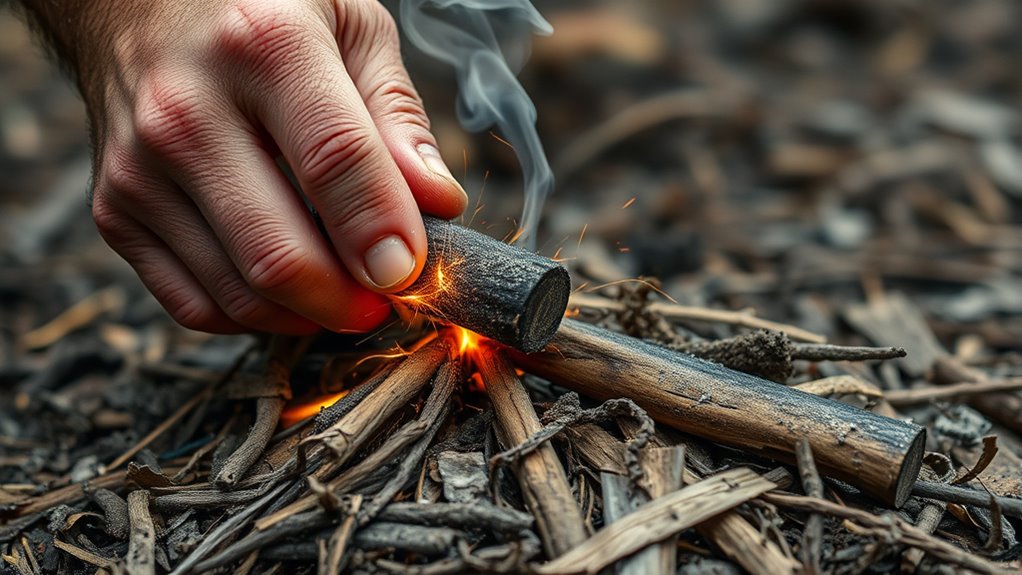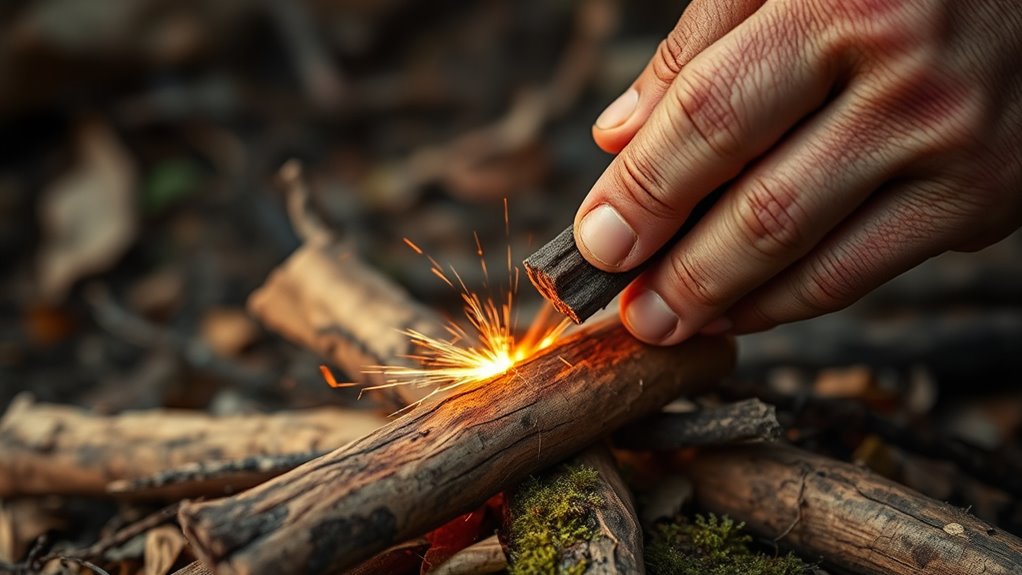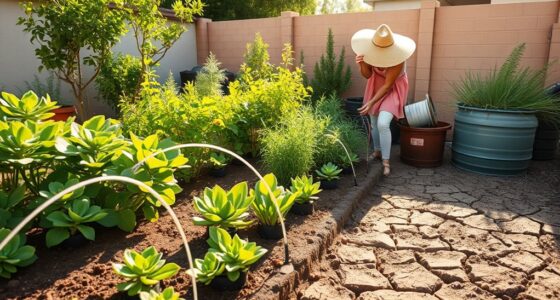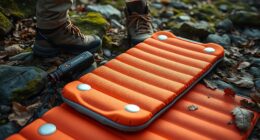To start a fire without matches, use a friction fire technique by rubbing a dry, straight wooden spindle against a softer fireboard until heat builds up and sparks an ember forms. Keep steady pressure and increase speed as you spin. Once an ember appears, transfer it carefully to dry tinder and gently blow to ignite. Patience and proper materials are key—if you keep practicing, you’ll discover even more primitive methods to create fire.
Key Takeaways
- Use the friction fire technique by rubbing a dry spindle against a fireboard until an ember forms.
- Select suitable materials like cedar, tupelo, or basswood for both spindle and fireboard.
- Maintain steady pressure and increase spinning speed to generate enough heat for ember creation.
- Gently transfer the ember to dry tinder such as grass or bark fibers, then blow softly to ignite.
- Gradually add small sticks and larger logs to build and sustain the fire once ignition occurs.

When matches aren’t available, starting a fire requires ingenuity and the right techniques. One of the most effective primitive methods is creating a friction fire, which involves generating enough heat through rubbing two pieces of wood together to produce a spark or ember. This process demands patience, practice, and the right materials, but it’s a reliable way to ignite a flame without modern tools.
To begin, you need to select suitable wood. The spindle, which is your main rubbing stick, should be dry, straight, and about the thickness of your thumb. The fireboard, or the base piece, must also be dry and softer than the spindle, such as cedar, tupelo, or basswood. The goal is to create enough friction to generate heat through rapid, consistent rubbing. You also want a notch carved into the fireboard to catch the ember, along with a small depression or pocket beneath it to hold the hot dust and ash.
Choose dry, straight, and soft wood like cedar or basswood for friction fire.
Once your materials are ready, position the spindle vertically in the notch on the fireboard. Using your hands or a bow drill if available, begin to spin the spindle rapidly back and forth, maintaining steady pressure downward. As you increase speed, friction heats the wood fibers, and eventually, you’ll see smoke forming at the notch. Keep up the effort, and soon you’ll notice a small, glowing ember—this is your spark creation. The ember is fragile, so carefully transfer it to your tinder bundle without breaking it.
Your tinder should be dry, fibrous material like dry grass, bark fibers, or shredded bark that’s easy to ignite. Gently place the ember into the tinder, then blow softly to encourage the ember to grow into a flame. Once the tinder catches fire, gradually add more small sticks and gradually larger logs to build your fire.
Creating a friction fire isn’t just about brute force; it’s about timing, technique, and patience. The key is consistent, vigorous rubbing to produce enough heat for a spark creation. If you don’t succeed on your first try, analyze what might have gone wrong—perhaps the wood was too damp, the pressure wasn’t steady, or the spindle wasn’t spun fast enough. With practice, you’ll develop a feel for the right materials and motions needed to turn friction into fire. Remember, the process is as much about persistence as it is about technique, and before long, you’ll be able to make fire happen with just your hands and some basic natural materials. Understanding the importance of high-quality materials] can significantly increase your chances of success.
Frequently Asked Questions
What Are the Safest Methods to Start a Fire Without Matches?
You want to start a fire safely without matches, especially for emergency preparedness. Use safe methods like a fire plow or bow drill, but always prioritize fire safety. Clear the area of flammable materials, keep water or a fire extinguisher nearby, and never leave the fire unattended. These primitive techniques require patience and practice, but they’re effective when done responsibly, helping you stay prepared while minimizing risks.
How Can I Find Suitable Tinder in the Wild?
Imagine walking through a forest, spotting dry grass and pine needles that crackle softly under your steps. To find suitable natural tinder, look for dry, fibrous plant material like moss, bark, or leaves. If you’re in an urban setting, gather shredded paper, lint, or cotton. Make certain your tinder is dry and fluffy, making it easier to ignite and sustain your fire. Always keep an eye out for the best, most combustible options around you.
What Are Common Mistakes to Avoid When Starting a Fire Primitively?
When starting a fire primitively, avoid common mistakes like neglecting fire safety; always clear the area of flammable materials and keep water nearby. Don’t underestimate the importance of equipment maintenance; make certain your tools are sharp and functional. Rushing or applying excessive force can cause accidents. Take your time, stay focused, and practice patience. By respecting safety guidelines and maintaining your gear, you increase your chances of success and prevent dangerous mishaps.
Which Natural Materials Are Best for Friction-Based Fire Starting?
You should focus on natural materials like dry, dense woods such as cedar or basswood for friction-based fire starting. Use fermentation starters like dried grass or bark to help ignite your tinder. Natural accelerants like pine resin or resinous wood shavings can also boost your chances. Guarantee materials are dry and well-prepared, as moisture hinders friction. Proper technique and patience will maximize your success with these natural resources.
How Do Weather Conditions Affect Primitive Fire-Starting Techniques?
Imagine weather as a tricky partner in your fire-starting dance. Rain impacts your efforts by soaking tinder and dampening friction, making sparks hard to ignite. Wind considerations become like a gusty coach, either fanning flames or extinguishing them. You need to adapt, using sheltered spots or windbreaks, and wait for calmer conditions. Weather’s unpredictable nature demands patience and skill, turning a simple task into a real test of your primitive fire-starting mastery.
Conclusion
Now that you know how to start a fire without matches, aren’t you curious about what other primitive skills you can master? With patience and practice, these methods become reliable tools in any survival situation. Remember, relying on these techniques not only boosts your confidence but also connects you with ancient survival instincts. So, are you ready to test your skills and keep the fire burning when it matters most?










